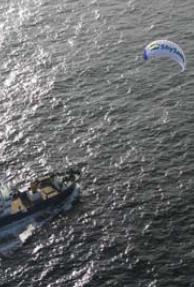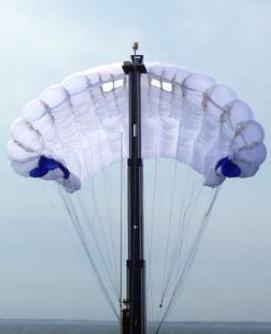This article is more than 1 year old
Germans debut kitesurf-powered autonomous windjammer
Avast there, Mr Computer, unfurl the sails
A new commercial cargo ship which will harness wind power to achieve greater fuel economy was christened in Hamburg on Saturday. MV Beluga SkySails will use an enormous, football-pitch sized tethered aerofoil to pull itself along, in much the same way as a kite-surfer.

Whoa, dude - that's one big kitesurf rig.
The company behind the high-tech windjammer, Beluga Projects, reckon their mega kitesurf rigs could be fitted to almost any ship, offering a 15 to 30 per cent improvement in fuel economy.
"This is the start of a revolution for the way ships are powered," Beluga chief Niels Stolberg told Reuters.
The inventor behind the SkySail kit, the excellently-named Stephan Wrage, suggested that the new-style sailing would significantly benefit the environment.
"The real motivating factor is... to prove it pays to protect the environment," he said.
"Fighting climate change makes us all proud."
Fuel savings to shipping companies will not be offset by increased manpower costs - one of the many commercial disadvantages of traditional sailing ships, which needed comparatively large crews. SkySail kites can be deployed and recovered automatically, at the touch of a button. They are operated fully autonomously by an onboard computer, requiring almost no supervision by bridge watchkeepers.
Another big advantage is the height at which the kites fly, up to 300m above the waves, where winds are steadier and stronger than near the surface. This gives SkySail a lot more push per square metre than a regular sail.

Setting sails by pressing a button.
Like any other form of wind power, the SkySail doesn't remove the need for a full-capacity baseload system, as the wind may be absent or dead foul. Furthermore, one does note that merchant ships - despite the fact that they carry the vast majority of the world's cargoes - emit only 5 per cent of the human race's carbon output. Anyway, an annual, global economic growth rate of just two per cent - mirrored in rising cargo tonnages - would wipe out a 15 per cent fuel efficiency gain in less than a decade.
Even in a world where every ship suddenly had a massive kite achieving 30 per cent efficiencies, that would equate to barely a one per cent worldwide CO2 saving, which would be wiped out by reasonable economic growth in less than 20 years.
So this isn't going to actually affect carbon emissions in any serious way at all. But it could well reduce fuel bills and make money for shippers - and thus for the technology's creators. Especially if fuel prices continue to stay at their present high levels.
The main caveat, as ever, is whether the tech can really live up to its promise of coping with all the sea can throw at it, reliably and largely hands-off. A significant part of the electronics is housed in a pod just below the kite; and the main method for the system to cope with really severe winds is to fly the aerofoil into a less high-stress flight position directly above the ship.
The time for Wrage and Stolberg to really celebrate will be after their gear has survived a few years down in 40-plus degrees of south latitude, with the wind gusting erratically to gale force and green seas breaking over the mooring point and winch.
The Reuters report is here. ®
